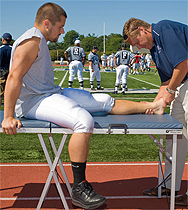Turf Toe

Turf toe injuries have become increasingly frequent in football. This is partly because of the popularity of more flexible shoes that allow increased toe motion. Turf toe injuries are caused by hyperextension of the great toe, where the toe is forced upwards, as in a football pile-up or tackle. These injuries are more common in linemen and receivers.
The severity of injury depends on the degree of soft tissue tearing at the joint. The joint at the base of the great toe (the 1 st metatarsophalangeal joint) becomes swollen, bruised, and painful with standing. Pushing off with the great toe while walking or running is especially painful. X-rays are obtained to look for a dislocation or fracture.
Treatment begins with rest, ice, compression, and elevation (RICE). A walking boot is worn to prevent motion at the joint. Most athletes with mild to moderate turf toe injuries return to sports in 4 weeks. Severe injuries may keep an athlete out for 6 weeks. Rarely, a turf toe may need surgery to repair the soft tissue tears. When the athlete returns to sports the toe is protected with taping, a stiff sole shoe, or a stiff orthotic to prevent re-injury to the joint.